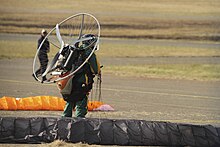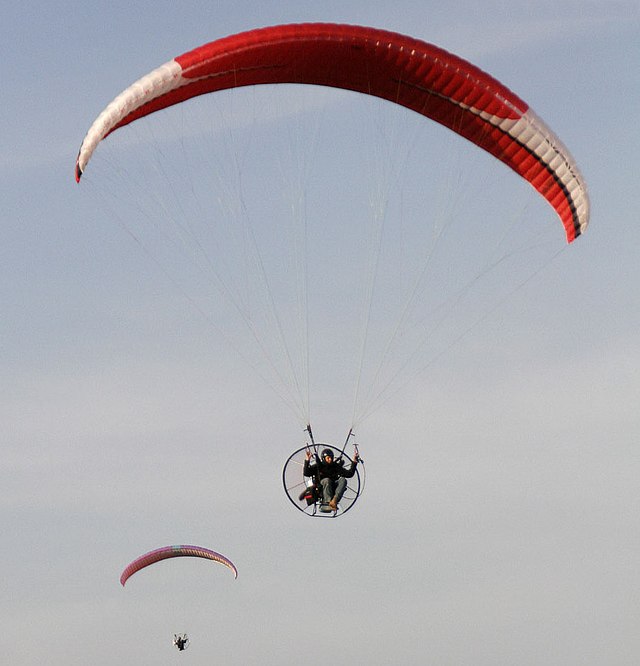Loading AI tools
Form of ultralight aviation From Wikipedia, the free encyclopedia
Powered paragliding, also known as paramotoring or PPG, is a form of ultralight aviation where the pilot wears a back-pack motor (a paramotor) which provides enough thrust to take off using a paraglider. It can be launched in still air, and on level ground, by the pilot alone—no assistance is required.
 | |
| Highest governing body | Fédération Aéronautique Internationale |
|---|---|
| Characteristics | |
| Contact | No |
| Mixed-sex | Yes |
| Type | Air sports |
| Presence | |
| Country or region | Worldwide |
| Olympic | No |
| World Games | 2017 |

In many countries, including the United States, powered paragliding is minimally regulated and requires no license. The ability to fly both low and slow safely, the "open" feel, the minimal equipment and maintenance costs, and the portability are claimed to be this type of flying's greatest merits.[1]
Powered paragliders usually fly between 15 and 50 mph (24 and 80 km/h) at altitudes from 'foot-dragging' up about to 18,000 ft (5,500 m) or more with certain permission.[2] Due to the paramotor's slow forward speed and nature of a soft wing, it is risky to operate in high winds, turbulence, or intense thermal activity, especially for inexperienced pilots.
The paramotor, weighing from 45 to 90 lb (20 to 41 kg) is supported by the pilot during takeoff. After a brief run (typically 10 ft (3.0 m)) the wing lifts the motor and its harnessed pilot off the ground. After takeoff, the pilot gets into the seat and sits suspended beneath the inflated paraglider wing like a pendulum. Control is available using right and left brake toggles and a hand-held throttle control for the motor and propeller speed. Some rigs are equipped with trimmers and speed bar to adjust angle of incidence, which also changes the angle of attack for increased or reduced speed. Brake toggles and weight shift is the general method for controlling yaw and roll (turning). Tip brakes and stabilo steering (if equipped) will also affect yaw and roll, and they may be used for more efficient flying or when required by the wing manufacturer in certain wing configurations such as reflex. The throttle controls pitch (along with speed bar and trimmers). Unlike regular aircraft, increasing throttle causes a pitch-up and climb (or reduced descent) but does not increase airspeed.
Paragliders are usually used for personal recreation, with some exceptions.
Powered paragliding has seen some military application including insertion of special forces soldiers and also border patrol in some governments. The Lebanese Airborne regiment adopted this technique in 2008. The US Army and Egyptian Army have used Paramotor Inc FX series units for many years, and these units are still under production.[3] During the outset of the 2023 Israel–Hamas war, Hamas militants used powered paragliders to infiltrate southern Israel, several of which were used in the Re'im music festival massacre.[4]
Because of limiting weather requirements, powered paragliders are not reliable replacements for most aviation uses.
They have been used for search and rescue, herding of animals, photography, surveying, and other uses, but regulations in most countries limit commercial activities.
Research estimates that the activity is slightly safer (fewer fatalities per thousand participants per year) than riding motorcycles and more dangerous than riding in cars.[5] The most likely cause of serious injury is body contact with a spinning propeller. The next most likely cause of injury is flying into something other than the landing zone.[6] Some countries run detailed statistics on accidents, e.g., in Germany in 2018 about 36,000 paragliding pilots registered 232 accidents, where 109 caused serious injury and 9 were fatal.[7]

Some pilots carry a reserve parachute designed to open in as little as 50 ft (15 m). While reserve parachutes are designed to open fast, they have a system length between 13.3 ft (4.5 m) and 21.9 ft (7.3 m)[8] and usually need at least 150 ft (46 m) to slow down a pilot to a safe sink rate (certified design speed according to LTF and EN certifications is max 18 ft (5.5 m) per second). With enough height over ground, many potential issues with the canopy can be resolved without applying the reserve parachute. The required skills can be acquired in SIV trainings,[9] which improve the overall safety of flying by providing a better understanding on the system limitations and practical training of extreme situations.
The lack of established design criteria for these aircraft led the British Air Accidents Investigation Branch to conclude in 2007 that "only when precise reserve factors have been established for individual harness/wing combinations carrying realistic suspended masses, at load factors appropriate to the maneuvers to be carried out, can these aircraft be considered to be structurally safe".[10]
Neither a license nor specific training is required in the U.S., U.K. or many other countries. Where there is no specific regulation (e.g., Mexico), paramotor flying is tolerated provided the pilots cooperate with local officials when appropriate.[citation needed] In countries where specific regulation exists, such as Canada, France, Italy, and South Africa, pilots must be trained, both in flying theory and practice, by licensed instructors. Some countries that require formal certification frequently do so through non-government ultralight aviation organizations.
Regardless of regulations, powered paragliding can be dangerous when practiced without proper training.
For a pilot to get through most organizations' full pilot syllabus requires between 5 and 15 days which, due to weather, may include far more calendar time. A number of techniques are employed for teaching, although most include getting the student familiar with handling the wing either on the ground, via towing, small hills, or on tandem flights.
With special gear, it is possible to take a passenger (tandem), but most countries, including the U.S., require some form of certification to do so.
In most countries, paramotor pilots operate under simple rules that spare them certification requirements for pilot and gear. Those laws, however, limit where they can fly—specifying that pilots avoid areas of urban/suburban population and larger airports to minimize risk to other people or aircraft. U.S. pilots operate under Federal Aviation Administration regulation Part 103. As powered heavier-than-air flying vehicles with wings, paramotors are technically a type of aircraft as defined in 14 CFR 1.1 - General definitions, which defines definitions for all FARs including part 103. [11]
In the United Kingdom, paramotors are regulated by the Civil Aviation Authority, are classified as self-propelled hang-gliders, and can be flown without registration or a license as long as they weigh less than 70 kg, have a stall speed not exceeding 35 knots, and are foot-launched.[12] Wheel-launched paramotors are allowed under the additional conditions that they do not carry passengers, and have a stall speed of 20 knots or less, but may weigh up to 75 kg if they carry a reserve parachute.[13]
In the U.S., the sport is represented primarily by the US Powered Paragliding Association (USPPA)[note 1] which also holds an exemption allowing two-place training by appropriately certified tandem instructors. The US Ultralight Association (USUA) and Aero Sports Connections (ASC) also offer some support.
Instructors in the U.S. are primarily represented and certified by the United States Powered Paragliding Association (USPPA).
In the United Kingdom, the sport is represented by the British Hang Gliding and Paragliding Association.
A powered paraglider (PPG) differs from a powered parachute (PPC) primarily in size, power, control method, and number of occupants. Powered paragliders are smaller, use more efficient (but more difficult to manage) paraglider wings, and steer with brake toggles like sport parachutists. Powered parachutes typically use easier-to-manage but less efficient wings, have larger engines, are steered by foot and may be able to take along passengers. There are exceptions; a growing number of powered parachutes use elliptical wings, some use hand controls, and many are light, single-seat aircraft that meet FAA Part 103 requirements.
Determined by the FAI, RPF1 category.[14]
Determined by Guinness World Records [16]
Seamless Wikipedia browsing. On steroids.
Every time you click a link to Wikipedia, Wiktionary or Wikiquote in your browser's search results, it will show the modern Wikiwand interface.
Wikiwand extension is a five stars, simple, with minimum permission required to keep your browsing private, safe and transparent.